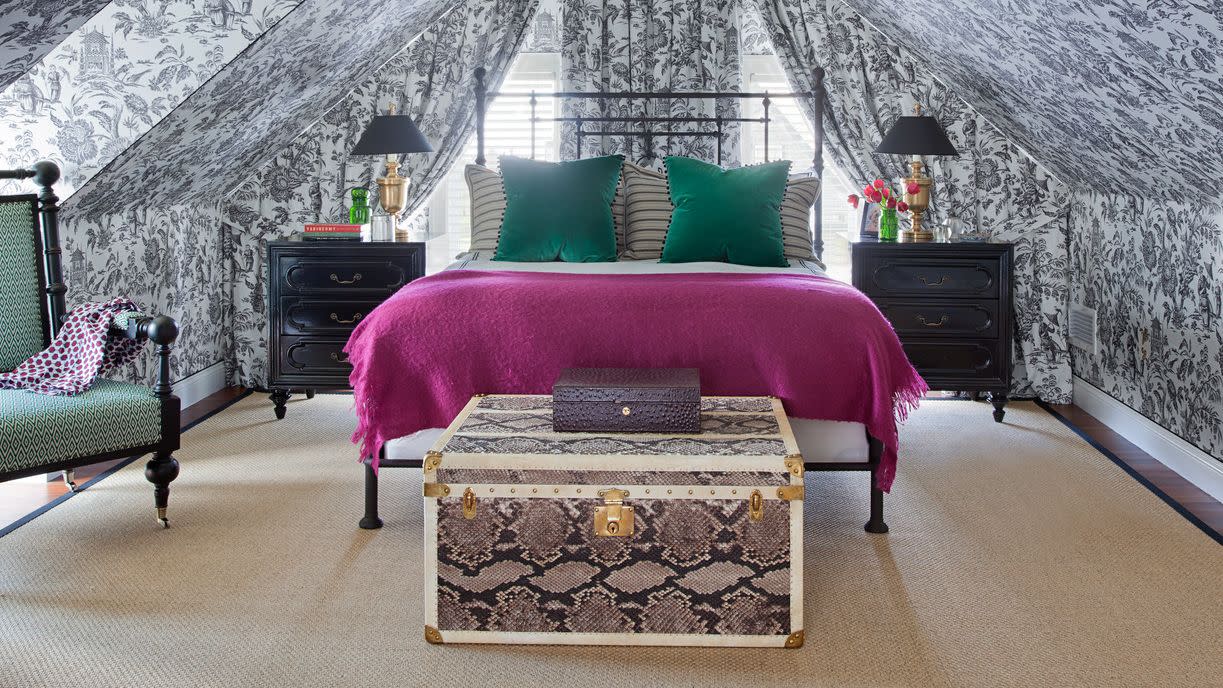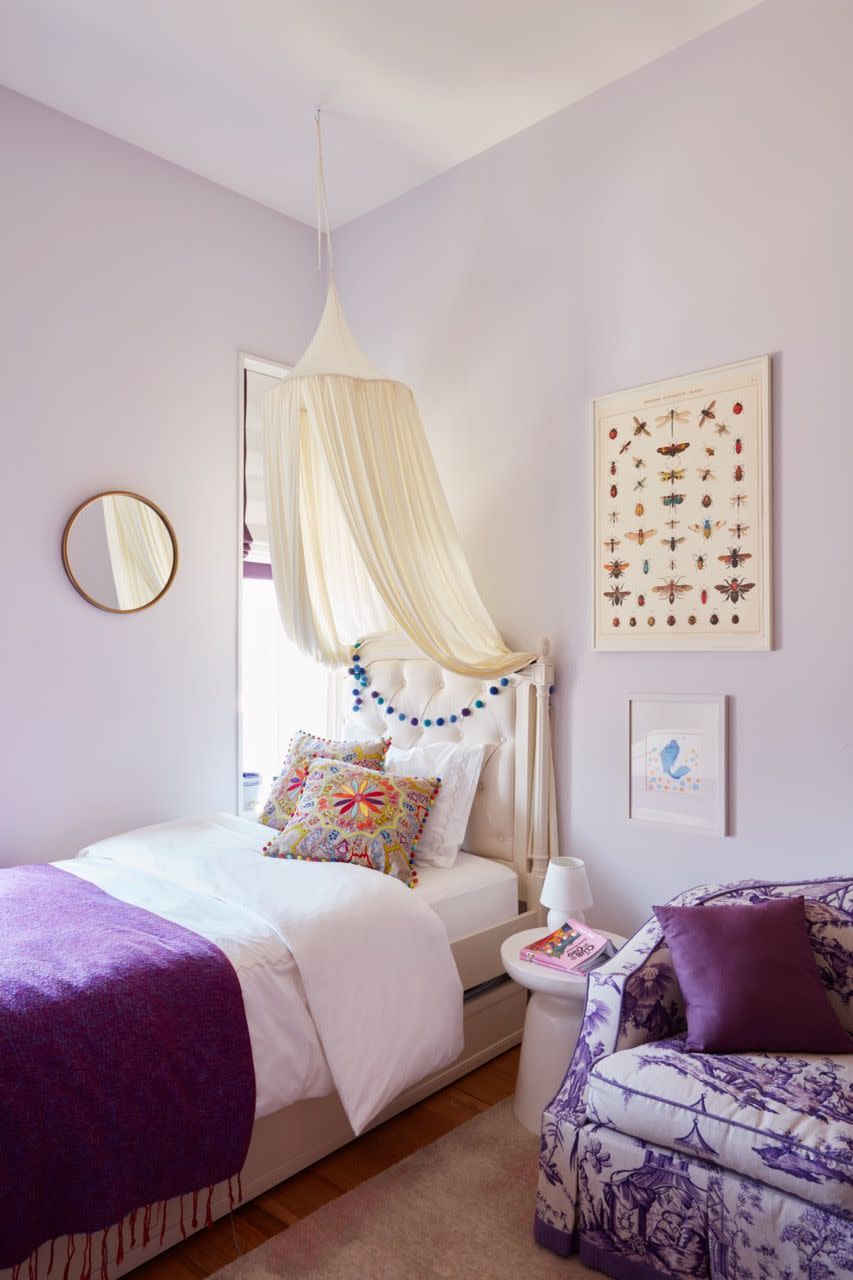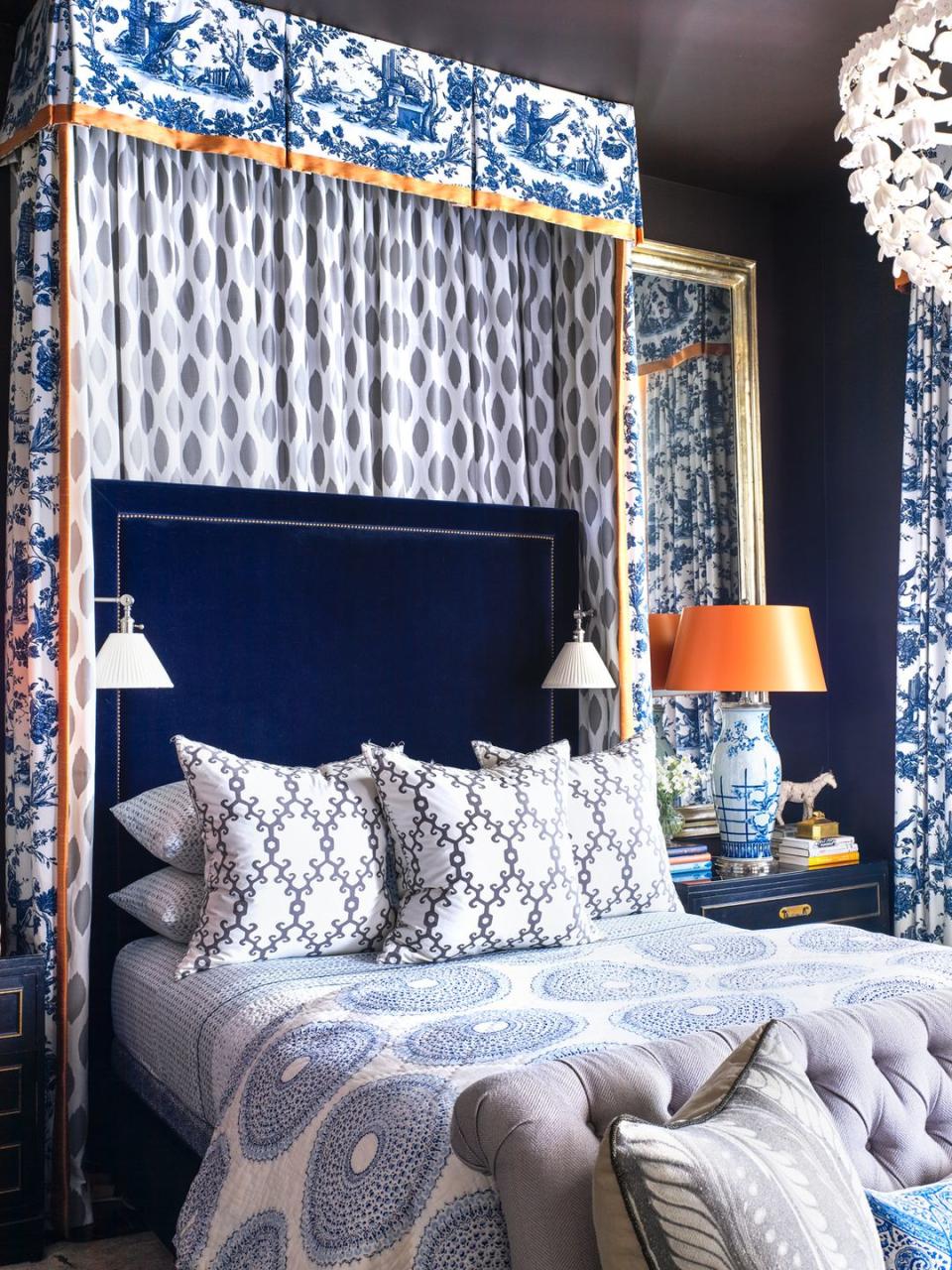This Classic French Print Is Poised for a Major Comeback This Spring

"Hearst Magazines and Yahoo may earn commission or revenue on some items through these links."
[table-of-contents] stripped
You’re probably familiar with toile de Jouy even if you don’t realize it. Whether you’re a maximalist or lover of traditional design, you’ve certainly encountered the iconic printed fabric, which has been around for centuries. Originally showing scenes of the pastoral French countryside, the toile pattern has evolved over the years to depict interpretations of modern times and is still used in both interiors and fashion today.
However, while you’ve likely seen the print before, you may not know much, or anything at all, about its storied history—or the difference between toile and toile de Jouy. With the help of two pattern-loving interior designers, we’re breaking down everything you need to know about this romantic and whimsical textile.
What Is Toile de Jouy?
Beloved by historians, classicists, and anyone who describes their style as Grandmillennial or cottagecore, toile de Jouy is the name for a cotton fabric directly printed with a pattern originally depicting bucolic scenes of the French countryside in blue and white. The name translates as “cloth from Jouy,” referring to the small French town of Jouy-en-Josas where the factory that first produced the textile was located. The scenes typically feature idealized images of shepherds or farmers, sheep and other livestock, botanicals, and possibly even a humble barn.
Is Toile the Same as Toile de Jouy?
It’s kind of complicated—and a little like another beloved French export, Champagne. Interior designer Sara See of Sees Design explains that the name of toile de Jouy has become an all-encompassing term for a general toile pattern that can depict any type of scene, not just one of the little French town. “There are different types of toile, and I think everybody just uses it interchangeably,” she explains. Technically, toile de Jouy should refer only to the single-color printed scene on cotton fabric that comes from and depicts Jouy-en-Josas. (The way Champagne should really only be used to refer to bubby that originates from the French wine region of the same name.) However, anytime you see a single-color printed fabric depicting any type of storytelling scene, people today might call it a toile de Jouy or a toile—even though technically it’s the latter.
History of Toile de Jouy
Two individuals get credit for the creation of this elegant pattern, according to The Irish Times and Schumacher. Irishman Francis Nixon invented copper-plate fabric printing in the 1750s, which allowed for large-scale and highly detailed printed textiles to be made and distributed more efficiently, especially the ones depicting the pastoral Jouy scenes. However, it was German industrialist Christophe-Philipe Oberkampf, with his small fabric factory in the town of Jouy-en-Josas, whose toile designs caught the eye of fashionable people of the time, such as Marie Antoinette and Madame de Pompadour. From there, the popularity of toile de Jouy exploded in the interior space, and it has been a classic staple in more traditional interior styles, and more modernly in fashion, ever since.
Toile de Jouy or toile patterns are still being used in interior design, but they’re not as limited by the traditional design elements as they once were. With modern interpretations and interior trends popping up, the iconic print is just as alive as ever.

Defining Characteristics of Toile de Jouy
Toile de Jouy typically is a white or ivory cotton ground printed with a blue pattern. If it’s a true toile de Jouy, the main point is that this pattern depicts a scene, almost as if it’s telling a story. According to Schumacher, the printed scene also must be monochromatic in color. Traditionally, the scenes depicted show “the quintessential bucolic women in the park and on swings, and animals, and husbandry, and children,” Jill Lasersohn, an antique textile collector tells Schumacher. However, toiles can also feature florals, mythical creatures, current events, and faraway places.
Why Is Toile de Jouy Having a Moment?
Toile de Jouy is having a bit of a resurgence because “casual and comfortable design” is too, See says. In that sense, it’s linked to the comeback of traditional design features like stripes, trellises, and tented rooms. “The look of less forced, contrived design is what’re all really dialing into right now…So maybe if we want to create some tension in the space between kind of casual and dressy, toile bridges that gap beautifully for us,” she explains.
Design, like fashion, is cyclical. As people move away from ultra-streamlined and very clean gray and white interiors, falling back into cozier, more classic styles makes sense. “I think people are a little bit like, ‘Okay, we’ve seen that, so let’s maybe try and infuse a little bit more interest in the walls and surfaces that surround the interiors,’” Garrow Kedigian, founder of his eponymous design firm, explains. “[Toile] kind of holds its own in a way. Whereas when you try and decorate a room that has only white walls, it’s really hard to do because you have to put so much stuff in the room to make it work.”
The bucolic scenes can make you feel nostalgic for something you’ve never even experienced, Kedigian explains, giving toile a whimsical feeling, and the fact that it’s traditionally printed directly onto cotton cloth—a casual fiber—makes it feel more inviting in the way of classic design. “I think that in order for something to feel lived-in and comfortable, you need to have organic elements,” See says. “The more of those elements that you layer into a space, the more you can create that feeling.”

How to Decorate Your Space with Toile de Jouy
While a toile-on-toile-on-toile room is a visually stunning and classic design approach, most people aren’t going to completely drown their rooms in one singular pattern, according to Kedigian. There are quite a few other ways you can integrate the pattern into a room beautifully, though, no matter what your overall design aesthetic is like. Kedigian suggests starting small, with less commitment to the toile, and adding more from there if you find that you’re really drawn to the pattern. (In other words, don't go straight for wallpaper.) “I often use things like toile or patterns like that as pillows because I think when people go into a room, unbeknownst to them, their eye usually goes right to the center of a sofa,” he says. “So that pillow that’s in the middle of a sofa is more important than anybody ever thinks, and it’s actually a critical thing to pick carefully.”
See, on the other hand, isn’t so attracted to the visual of a pastoral scene being so evident in a room and suggests using toile for drapery. “I just kind of like knowing it’s there. So if it’s tucked into some pleats in a beautiful floor-to-ceiling drapery, it’s there but you don’t need to know that somebody is leading cows into pasture,” she explains. “You still are wrapped in that feeling without having to be quite so literal.”


By Matthew Bees
When it comes to more modern takes on the pattern, both See and Kedigian like experimenting with different color combinations in the toile itself. Pink and white, pink and red, inky black and white, burnt orange and blue—using different hues allows you to have more freedom with the overall color story while still capturing the romantic feel.
However, the most important thing to keep in mind with any use of toile de Jouy, according to See, is scale. Because toile is generally a large-scale print, See emphasizes how the scale of the textiles and other patterns used with it truly matters for balancing out a space. “Depending on how fine the details are on the toile, maybe I need a smaller, kind of ditzy print to go with it in the same space,” she says. “It would be important to me to maybe have a velvet or a mohair or something that can really hold its own in the space against what would likely be a cotton toile.”
If you’re looking for something still a bit bolder, though, Kedigian likes to pair the organic toile with geometric stripes or plaid. “I feel like they counterbalance each other, and I think that the stripe or the plaid will give the toile a little bit of structure,” he explains. Toile de Jouy is definitely a more versatile pattern than you might’ve initially thought.
Examples of Toile
Some modern designers have taken the toile de Jouy pattern to the next level and modernized the scenes the cloth presents. Sheila Bridges created Harlem Toile de Jouy, possibly one of the most famous reinterpretations of the classic French pattern. Her design, which started out as a solution to not being able to find the perfect toile for her home, recreates the pastoral scenes featuring modern-day African-American life in New York City. It’s available in wallcoverings, bedding, glassware, plates, and more.
Other modern examples of the toile can be seen in Flavor Paper’s Brooklyn Toile, Rachel Antonoff's Sopranos-themed Jersey Toile, Hygge & West’s Back to the Future–themed Hill Valley Toile, and Schumacher’s own Toile de Femmes, part of a collaboration with Peg Norriss, which shows modern women going about their lives. If Kedigian’s prediction is correct, we can expect to see even more of these unexpected interpretations and uses of the elegant pattern in the future.
Follow House Beautiful on Instagram and TikTok.
You Might Also Like

